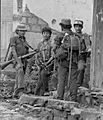Salvadoran Civil War facts for kids
The Salvadoran Civil War was a long and difficult conflict in the country of El Salvador. It lasted for 12 years, from 1979 to 1992. The war was fought between the government of El Salvador and a group of left-wing rebels. This conflict caused a lot of changes and challenges for the people of El Salvador.
Contents
What Caused the Salvadoran Civil War?
The Salvadoran Civil War began because of many problems in El Salvador. For a long time, a small group of wealthy families and military leaders held most of the power and money. Many ordinary people were very poor and had little say in how the country was run.
Unfairness and Lack of Rights
People were unhappy because there was a lot of unfairness. Many citizens did not have basic rights, and anyone who spoke out against the government often faced harsh treatment. This made many people feel like they had no other choice but to fight for change.
Rise of Rebel Groups
Because of these problems, several small rebel groups started to form. These groups wanted to create a more equal society where everyone had fair opportunities. Eventually, these groups joined together to form a larger organization called the Farabundo Martí National Liberation Front, or FMLN.
The Role of the Military Government
Before the war, El Salvador was mostly ruled by military governments. These governments often used strong force to control the population. This made the situation worse and pushed more people to support the rebel groups.
Key Moments During the War
The war was a very tough time for El Salvador. Many important events happened that shaped the conflict.
Archbishop Óscar Romero
One important person during this time was Archbishop Óscar Romero. He was a religious leader who spoke out against the violence and unfairness in the country. He asked the government to stop hurting its own people. Sadly, he was killed in 1980 while giving a sermon. His death made the conflict even more intense.
International Involvement
Other countries also got involved in the war. The United States government supported the Salvadoran government, providing them with money and military help. Other countries, like Cuba and Nicaragua, supported the FMLN rebels. This made the war part of the larger "Cold War" between the United States and the Soviet Union.
Life for Ordinary People
During the war, daily life was very difficult for many Salvadorans. Many people had to leave their homes and become refugees, seeking safety in other countries like Honduras or the United States. Towns and villages were often caught in the fighting, and many innocent people suffered.
How Did the War End?
After many years of fighting, both sides realized that a military victory was unlikely. People were tired of the violence, and there was a strong desire for peace.
Peace Talks and Agreements
Leaders from the government and the FMLN began to talk about peace. These talks were difficult and took a long time. Finally, in 1992, they signed a peace agreement called the Chapultepec Peace Accords. This agreement was signed in Mexico City.
What the Peace Accords Changed
The peace agreement brought many important changes to El Salvador. The FMLN became a legal political party, and the military was reformed. It also promised to protect human rights and create a new police force. The war officially ended, and the country began the long process of rebuilding.
Images for kids
-
Gen. Carlos Humberto Romero, military president of El Salvador (1977–1979). His presidency was characterized by increased civil unrest and government repression.
-
Archbishop Óscar Romero
-
José Napoleón Duarte at a Christian Democratic Party press conference during the Salvadoran war (1982)
-
President Alfredo Cristiani, September 1989
-
Monsignor Óscar Romero Memorial Plaza in Los Angeles.
See also
 In Spanish: Guerra civil de El Salvador para niños
In Spanish: Guerra civil de El Salvador para niños













